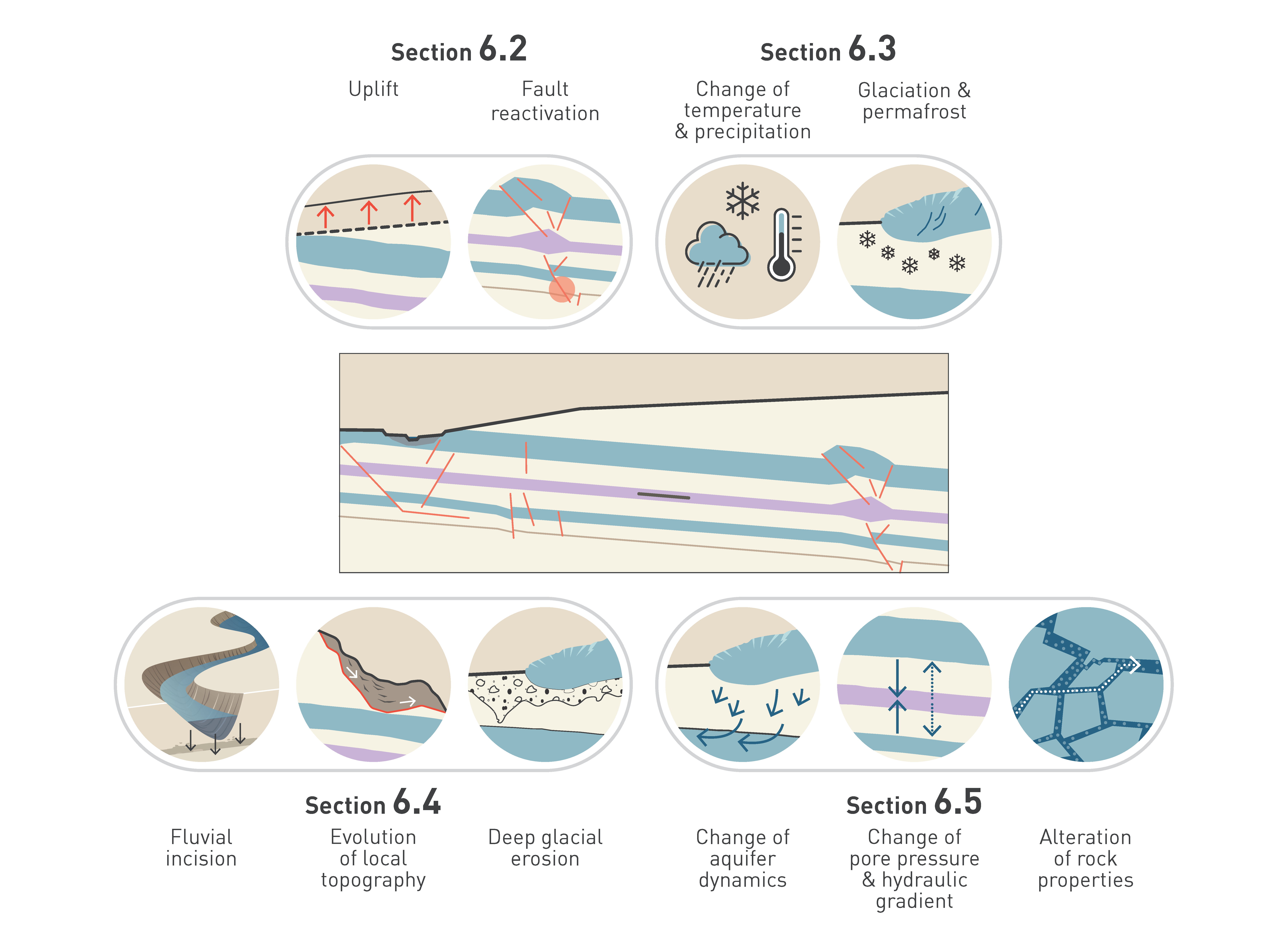This chapter addresses the changes in environmental conditions related to surface-driven, climate-driven, and geological processes that may affect the long-term stability of the geological barrier. Consequently, the principal topics to be addressed in this context are changes in transport properties (hydraulic conductivity, diffusion coefficients), hydraulic gradients, stress state and fault reactivation. Of particular importance in such an analysis is the consideration of the reduction in sediment cover thickness (referred to herein as overburden) above host rock under various tectonic and erosion scenarios. The latter is important because the barrier properties are "depth-dependent" and will persist as long as a minimum residual overburden is maintained above the rock units that host a future repository in the Opalinus Clay. Future erosion may reduce the overburden.
The assessment of future erosion potential considers the form and rate of processes in the past (Quaternary) as a basis for evaluating future variability in tectonic and surface processes that could affect the containment and isolation function of a repository or its geological barrier up to one million years into the future.
This assessment builds on the process understanding gained during earlier studies (e.g. Müller et al. 2002, Nagra 2014c, Dossier III). In SGT Stage 3 a targeted scientific field investigation programme was launched to provide a better understanding of the long-term Quaternary evolution of Northern Switzerland (Section 2.4). These investigations were accompanied by numerical modelling studies and an in-depth literature review aimed at gaining a state-of-the-art process understanding of the main drivers for erosion of the landscape in Northern Switzerland. The erosion scenarios and argumentation from SGT Stage 2 (Nagra 2014c, Dossier III) were thus updated and improved to incorporate and illustrate uncertainties in a systematic and structured way. This effort includes the design of a new model cascade that allows the combination of numerical simulations and probabilistic calculations to estimate future repository overburden thickness and excavation probabilities. The most relevant results are presented and discussed in this chapter; further details are provided in additional reports (Nagra 2024l, 2024j, 2024k).
Chapter 6 is structured as follows (Fig. 6‑1):
-
Section 6.1.2 provides an overview of potentially relevant processes affecting the surface process and tectonic regimes of Northern Switzerland.
-
Section 6.2 describes the geodynamic evolution of Northern Switzerland with a focus on (1) crustal uplift/subsidence patterns as drivers for erosion and sedimentation, and (2) the potential for faulting near the repository locations.
-
Section 6.3 reviews the Quaternary climate evolution and its influence on the surface process regime in the light of recurring orbital changes and natural atmospheric CO2 levels. This review forms the basis for a consideration of possible global future climate scenarios in the context of predicted orbital changes and anthropogenically influenced CO2 levels. Subsequently, these climate states and cycles are reviewed with respect to their regional impact in Northern Switzerland, especially regarding glaciations and the occurrence of deep-reaching permafrost. Finally, the results of ice-flow modelling with respect to erosion potential and estimates of future glacial inception are discussed.
-
In Section 6.4, changes in tectonic and climate processes are reviewed as potential drivers for erosion processes. In this context, the evolution of the principal drainage systems, the response of local topography to changes in tectonic and climate-driven processes, and particularly the character of glacial overdeepenings is presented in separate subsections. Subsequently, the new approach for estimating future erosion under consideration of uncertainties is introduced. Finally, the results of the assessment of future erosion (i.e. remaining overburden thickness and excavation probabilities) are summarised.
-
Section 6.5 discusses the effects of tectonic and climate-driven processes and associated reduction in overburden thickness on hydrogeological conditions in the low-permeability geological barrier and surrounding aquifers. This discussion also considers changes in aquifer dynamics and host-rock properties, as well as the evolution of geochemical conditions in the host rock.
-
The chapter concludes in Section 6.6 with a summary of the processes most relevant to the expected landscape and barrier evolution in the area of the deep geological repository. In addition, this section addresses findings that are relevant for site selection and long-term safety.

Fig. 6‑1:Schematic visualisation of the principal geological processes potentially affecting the geological barrier and corresponding structure of the chapter
The main aspects that are addressed with respect to future repository performance and long-term safety are tectonic evolution with vertical motion as a driver of erosion and fault reactivation potential (Section 6.2); climate evolution as a driver of erosion and changes in hydrogeological conditions, such as changes in temperature and precipitation as well as ensuing glaciations and the formation of deep-reaching permafrost (Section 6.3); erosion with the three main components fluvial incision, evolution of local topography, and deep glacial erosion (Section 6.4); and the hydrogeological evolution including changes in properties of the aquifer flow system and pore pressure and thus in the flow system and the alteration of porewater and dissolution processes (Section 6.5).

